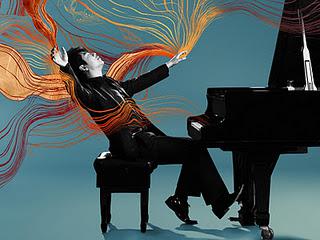Lang Lang celebrates Liszt's 200th at the Kimmel Center.

This didn't actually happen at the concert, but it's what Liszt sounds like.
Pianist Lang Lang. Photo © 2011 courtesy Sony Classical.
On Saturday night, the Philadelphia Orchestra, led by Chief Conductor Charles Dutoit, celebrated the birth of a composer and the death of a dictator. The composer: Franz Liszt, whose 200th birthday was celebrated by guest pianist Lang Lang. The dictator: Joseph Stalin, whose systematic terrorization of Russian composers remains a black memory of the last century.
The program opened with Shostakovich's Tenth Symphony. With this work, Shostakovich broke a self-imposed silence following the second round of Soviet artist purges in the aftermath of World War II. The work, one of the composer's most popular and tightly constructed symphonies sets up a contest between the composer's autobiographical "D-S-C-H" theme (D-E♭-C-B♮) against a whirling tornado of sound representing Stalin and his thugs. In the final showdown, the Shostakovich theme wins, sounding out triumphantly in the brass.
From its subtle, almost imperceptible opening in the double basses, Mr. Dutoit led this work with passion and authority. He bent almost double in the fast "Stalin" movement, driving the orchestra with precision where other conductors generate brassy noise. The last two movements featured stellar wind playing from the Philadelphians, climaxing in a driving reprise of the "motto" theme in brass and timpani.
The Liszt celebration opened with a choice that reflected Liszt as a showman: Karl Müller-Berghaus' orchestration of the Hungarian Rhapsody No. 2. This flashy piano piece (featured in Tom and Jerry cartoons and a memorable scene in Who Framed Roger Rabbit was played with charm by the full orchestra.
When Lang Lang took the stage, nobody fainted. Nobody threw their panties, room keys, or other fannish items. The lights in Verizon Hall were brightened to facilitate filming, and the genial pianist sat down at the Steinway to play Liszt's First Piano Concerto.
Liszt built this concerto by folding four movements into one, which can create pacing problems that the conductor and soloist must work together to solve. Mr. Lang played the stentorian opening with a powerful attack, and then dripped sweet, creamy tone from his fingers with the first lyric outpourings of his instrument.
Mr. Lang attended the Curtis Institute and has great reverence for the Philadelphia Orchestra. Their skilled accompaniment showed that the respect was mutual. Pianist and orchestra down-shifted into the slow movement and then to the short Allegro with its chiming triangle. The finale brought all the movements together in a stunning display of virtuoso playing that also validated Liszt as a masterful composer for orchestra.
If Mr. Lang chose to, (or were allowed to) smoke cigars onstage at Verizon Hall, his stogie would be preserved in a jeweled reliquary. He played an encore instead: a lush, sensuous reading of the Liebestraum. The evening ended with pianist, orchestra and even audience joining for a bicentennial reading of "Happy Birthday" for Mr. Liszt.

